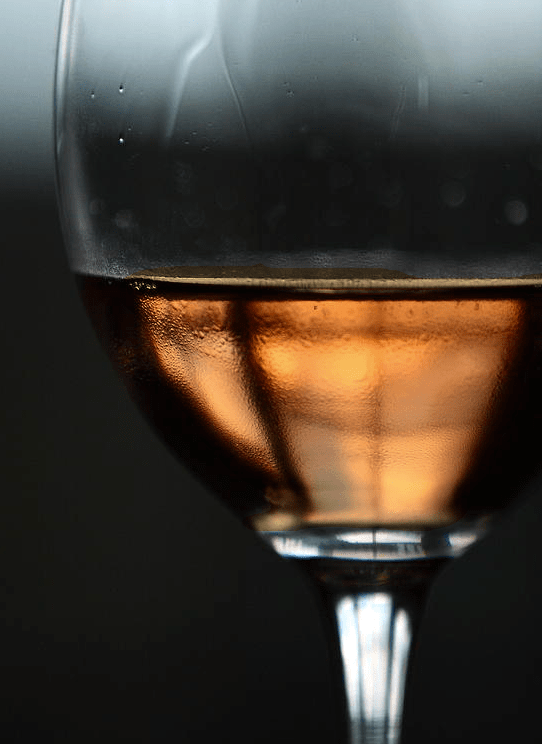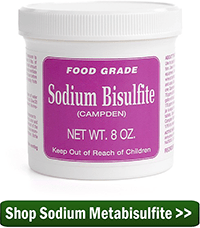 Last fall I acquired some good wine grapes.. red and white not enough of either for 5 gals.. thought I could make a blush, so I added them together.. it turned a reddish color but cloudy. So I added bentonite three weeks later i have clear brown color, what happened?
Last fall I acquired some good wine grapes.. red and white not enough of either for 5 gals.. thought I could make a blush, so I added them together.. it turned a reddish color but cloudy. So I added bentonite three weeks later i have clear brown color, what happened?
Thanks Art
—–
Hello Art,
It sounds like your homemade wine has oxidized from excessive air exposure. Just like when an apple starts to turn brown after being bitten into, a wine can turn brown when it is exposed to too much air. This is called oxidation.
It was not necessarily caused by letting the wine be in touch with the open air, but in your case, probably had more to do with excessive splashing of the wine when you where using the bentonite. When you splash a wine air can saturate into it much more quickly than if the wine was just sitting still.
Unfortunately, there is no real effective way to reverse this browning effect of oxidation on a homemade wine. However, there are things you can do in the future to reduce its chances of happening again:
- Keep Splashing To A Minimum: When stirring the wine, stir it in a way that blends the wine but does not splash it. When siphoning or racking the wine, have the end of the hose down into the wine in the fermenter you are filling up. Fill the vessel from the bottom up, so to speak.
- Add Sulfites To The Wine After Racking: This should only be done to a wine that has completed its fermentation. You can use either Campden tablets or sodium metabisulfite to add sulfites to the wine. The sulfites will help to drive out any saturated oxygen that is in the wine before it has time to negatively affect the wine. You only need to add around 1/2 a standard dose. That would be either 2-1/2 Campden Tablets or one heaping 1/8 teaspoon to 5 gallons of wine.

- Keep Out Of The Heat And Light: Both heat and light will increase a wines susceptibility to oxidation. By keeping the wine in a dark, cool place you are helping to protect the wine from the effects of oxidation.
Now that you are aware that a homemade wine can turn brown from oxidation, I think you can understand that controlling oxidation when making wine is important. Do the three simple thing above, and you will go a long ways oxidation to an unnoticeable level
Best Wishes,
Customer Service at E. C. Kraus
—–
Ed Kraus is a 3rd generation home brewer/winemaker and has been an owner of E. C. Kraus since 1999. He has been helping individuals make better wine and beer for over 25 years.

When degassing a wine w/ drill paddle or a spoon are you supposed to do it vigorously, creating a foam or just stir it gently, so as not to cause to much introduction of air causing oxidation to take place??????/
Paul, When degassing you can stir as hard as you want. What you don’t want to do is splash. Splashing is what increased the rate at which oxygen can saturate into the wine.
Let me be sure I under stand. If I filter my wine and leave in carboy for a few weeks I should add 1/8 tsp metabisulfite to preserve correct.
Rob, yes that is correct. The dosage is 1/8 teaspoon if you are making 5-gallons of wine.
If I add campden tablets or the metabisulfite when making the wine initially, should I still add it on the back end also?
Tom, yes you still need to add campden tablets when you bottle the wine to prevent spoilage. The following article will discuss when to use campden tablets.
Campden Tablets
http://www.eckraus.com/blog/add-campden-tablets-to-wine
This is especially important with white wines, rather than reds, where, if oxidation occurs, it is not as noticeable. I have never had it occur in a red, so something else is prolly helping. Also, we risk oxidation in white wine if it sits too long between stages – I have had this happen as well. It’s a great hobby that generally “waits for you”, however, Mother Nature does have her limits. Take care.
When I filter wine I also add a teaspoon of Ascorbic Acid per five gallons as an anti-oxidizer.
I was at the tail end of the process of making 3 gals of sparkling apple cider from apples pressed from our orchard. I used 3 campden tablets at the pressing and the fermentation went well, the cider cleared without fining, tasting very dry but with good cider flavor. The process was done in a carboy with an air lock. Right before adding sugar and bottling, I noted the wine was a little cloudy, so decided to rack it off what little sediment there was at the bottom and add an ounce of isinglass and let it sit for a couple more days to clear. After racking and stirring in the fining agent, the cider started changing color due to oxidation right before my eyes. By the time I got a few campden tablets crushed, the color was a dark brown, and tasted oxidized (terrible). What did I do wrong? Is there anything that can reverse the process and is there any use for this juice now that it is oxidized. Could I make it into cider vinegar or should I dump it?
Since you state you are shooting for sparkling apple wine, I’d recommend you go forward with the process. If you can get it to re-ferment, that may take out the oxygen. Fermentation needs oxygen to start, and that may work.
If you leave green grapes on their skins you will often end up with a amber colored wine. Might have happened when you mixed the grapes if you let them set on the skins.
Speaking as someone who owns/operates an on-premise winemaking shop and has helped winemakers make over a thousand batches of kit wine, here’s another easy tip to remove oxygen from wine during various process steps…
After fermentation, after degassing (yes whip it violently), from that point forward until bottling put the wine under vacuum. Simply get one of wine bottle vacuum devices like a Vacuvin pump (about $10). Using universal carboy bung and Vacuvin bottle top fitting together, you can create vacuumizable stopper for your carboy. When you’re done working with the wine (transferring it, adding fining agents, filtering, etc.), don’t use a standard airlock. Use the vacuum stopper. Pump the top of the carboy, creating a vacuum in the head space over the wine. Any air that was introduced or saturated into the wine is drawn out naturally. Again leave the carboy vacuumed until you’re ready to bottle – could be days or even weeks. In our winemaking shop which has been in business for out 4 years, all wines in process either have an airlock (if in primary or secondary fermentation) or are keep under vacuum. Total cost of my suggestion is about $10-15 in the form a small wine vacuum pump and a carboy universal bung. Contact me if you have any questions.
Mike,
Do you keep the carboy vacuumed during the secondary fermentation or do you use an airlock? I’m using a vacuum and wondering if I’m doing the right thing. Thanks
I just pump a little CO2 into every carboy to displace what air might be there. If you have a kegging system, it’s easy to adapt it to this purpose. Otherwise, there is a portable Keg Charger that uses the little CO2 cartridges. Squirt some CO2 in for a few seconds. I have yet to have had an oxidized wine. An old school winemakers method was to drop a campden tablet into the carboy at every racking, it forms a sulfur gas as it dissolves and pushes out any air remaining at the top. Since I know people that are sulfite sensitive, I prefer the CO2 method.
Talk about “PANIC”…
We just got a new head Pastor at our church…as I’ve done with my Mens’ Group and the other Pastors, I gave the new Pastor and his wife a bottle from my recent small batch (10 bottles, bottled about 30 days ago) of Frontenac (red) wine…as a simple welcome gesture. I had also given my oldest son a bottle which he opened early and said he got sprayed with foam, like a pop bottle…going down my list I noted that the new Pastor’s bottle had come from that same batch…(expletive!, expletive!)…I told my wife and she said “…best you leave town in the wee hours of the morning…I’ll tell everyone you were kidnapped by terrorists”……SO…I took the remaining bottles, de-corked them, sanitized everything, carefully poured them into a clean Carboy, attached to my drill a make-shift sanitized degasser which was a fiberglass rod with chamois flaps on one end (for cleaning bottles), sub-merged it in the wine, and started the drill…BUBBLES GALORE!…after a while the bubbles diminished, with only smaller amounts bubbling…( Note: a lot of clustered leas came out when I carefully poured each bottle’s contents into the new carboy). I added one Campden tablet to each of the 1 gallon Carboys)
I plan to re-bottled the batch very soon, then notify my new Pastor…either from my home here…or from jail!
Any thoughts and predictions??? I have never even thought of “degassing” my previous wines, trusting in my hydrometer readings.
I am ready to bottle my wine, so I am preparing for sanitizing bottles I had collected. Having C-brite from few years back, when brewing beer, but with very smudged print, I was ready to use as sanitizer, but not remembering the dilution ratio, I checked internet. Beside the ratio, I also found very contradicting information. So, I am not sure now if it is even good idea to use it for wine making.